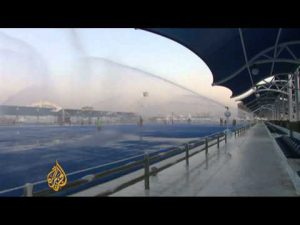The Hashemite Kingdom of Jordan has wrapped up a national phase-out of all central cooling systems using chlorofluorocarbons (CFC), reports the Jordan Times: “Jordan’s program for phasing out the use of CFCs, aimed at disposing 1500 tons of the harmful substance, was achieved one year ahead of schedule”, said Ghazi Odat, Director of the Ministry of Environment’s ozone project. Odat said replacing these systems in 165 facilities also reduced energy consumption. The program was funded by a $2.16 million grant from the Multilateral Fund for the Implementation of the Montreal Protocol, granted to the Kingdom in May 2010. Jordan is a signatory to the Montreal Protocol.
CFCs in a nutshell
CFCs are organic compounds comprised of carbon, chlorine, and fluorine; commonly used in aerosols and as refrigerants until they were proven to be agents in atmospheric ozone depletion. CFCs also reduce the ability of the ozone layer to absorb harmful ultraviolet rays, contributing to global warming.
Developed in 1928 as ideal gases for refrigeration, with special characteristics such as inflammability and low-toxicity to humans, CFCs were mass produced in developed countries commencing from the 1960s.
In 1985, observation of an ozone hole near the Antarctic Pole provided proof that the atmospheric ozone layer was depleting. Two years later, the Montreal Protocol on Substances that Deplete the Ozone Layer was adopted, inciting development of CFC alternatives.
HCFCs to the rescue?
Hydrochlorofluorocarbons (HCFC) are fluorocarbons that contain hydrogen. Commonly known by trade name Freon, HCFCs are low-in-toxicity, cost effective and considered somewhat less destructive to the atmosphere than their hydrogen-free cousins. Supported by both industry and environmentalists as the lesser of the fluorocarbon evils, HFCFs have been systematically replacing CFCs.
In the past decade, HFCF use has precipitated a 75% drop in worldwide CFC consumption. But developing countries continue to increase their CFC use. HCFCs are playing a vital role in weaning the world off CFCs.
Not a panacea: HCFCs also damage the ozone.
Under the Montreal Protocol, and by prescribed deadlines, developed nations must achieve specified progress towards total phase-out of HCFC production and consumption. As example, the USA is required to stop production and importation by 2030.
At the 19th Meeting of the Parties to the Montreal Protocol in September 2007, the Parties agreed to a more aggressive phasedown of HCFCs; now seeking to step down usage in both developing and developed countries.
It’s estimated that almost 2000 Jordanian facilities have central cooling systems that use HCFCs. Eight months ago, the Ministry of Environment launched a national strategy for phasing them out too. The Montreal Fund will also provide financing for the HCFC reduction, targeting a cut in use by 20 per cent by 2017.
Developed countries have led the transition, and participation by the developing world is increasing. Today total ozone depletion contributions are at their lowest levels since the Parties began discussions.
Good news for Jordan, and for the world.
Image of ozone earth from Shutterstock




